Nissan Pathfinder: Engine Cooling System - Engine Coolant
System Inspection
WARNING:
-
Do not remove the radiator cap or reservoir tank cap when the engine is hot. Serious burns could occur from high-pressure engine coolant escaping from the cooling system.
-
When removing the radiator cap or reservoir tank cap, wrap a thick cloth around the cap and slowly turn it a quarter turn to allow built-up pressure to escape. Then carefully remove the cap by turning it all the way.
CHECKING COOLING SYSTEM HOSES
Check hoses for the following:
-
Improper attachment
-
Leaks
-
Cracks
-
Dents
-
Bulges
-
Internal obstruction
-
Damage
-
Loose connections
-
Chafing
-
Deterioration
CHECKING RESERVOIR LEVEL
-
Check if the reservoir tank coolant level is within MIN to MAX when the engine is cool.
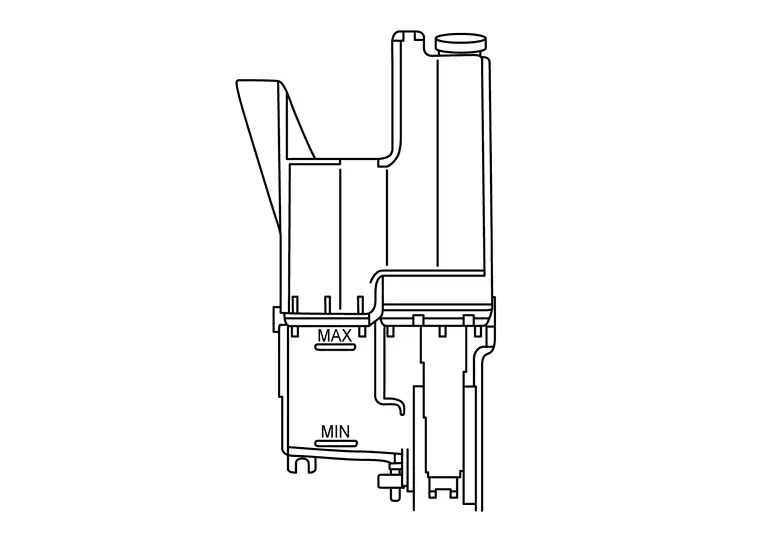
-
Adjust coolant level (if necessary), to ensure that the engine coolant level is within the MIN to MAX range.
CAUTION:
Refill Genuine NISSAN Long Life Antifreeze/Coolant (blue) or equivalent in its quality mixed with water (distilled or demineralized). Refer to Fluids and Lubricants (United States and Canada) or Fluids and Lubricants (Mexico).
CHECKING COOLING SYSTEM FOR LEAKS
WARNING:
-
Do not remove the radiator cap or reservoir tank cap when the engine is hot. Serious burns could occur from high-pressure engine coolant escaping from the cooling system.
-
When removing the radiator cap or reservoir tank cap, wrap a thick cloth around the cap and slowly turn it a quarter turn to allow built-up pressure to escape. Then carefully remove the cap by turning it all the way.
To check the cooling system for leaks, apply pressure to the cooling system using Tools (A), (B), (C) and (D).
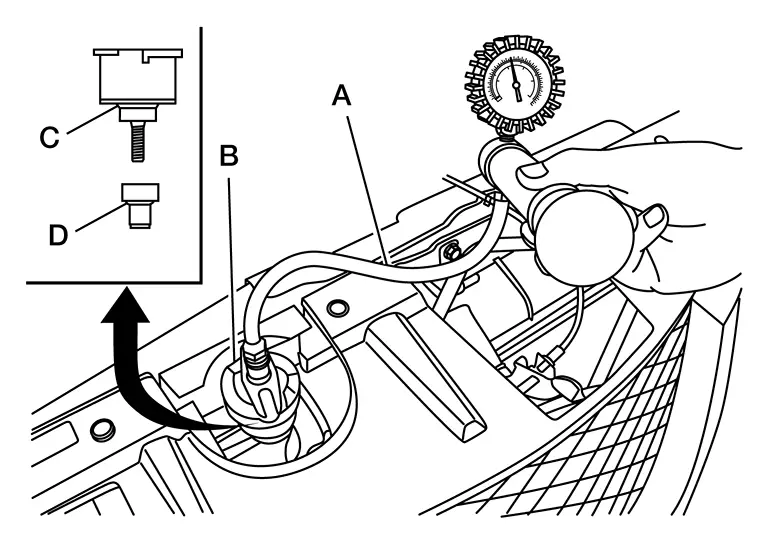
| Tool number (A) | : — (NI-51771-5) |
| Tool number (B) | : — (NI-51771-9) |
| Tool number (C) | : — (NI-51771-1) |
| Tool number (D) | : — (NI-51771-4) |
| Leakage test pressure | : Refer to Radiator. |
CAUTION:
Higher testing pressure than specified may cause radiator damage.
 NOTE:
NOTE:
-
If engine coolant decreases, replenish radiator with engine coolant. Refer to Fluids and Lubricants (For USA and Canada) or Fluids and Lubricants (For Mexico).
-
If anything is found, repair or replace damaged parts.
CHECKING RADIATOR CAP
WARNING:
-
Do not remove the radiator cap or reservoir tank cap when the engine is hot. Serious burns could occur from high-pressure engine coolant escaping from the cooling system.
-
When removing the radiator cap or reservoir tank cap, wrap a thick cloth around the cap and slowly turn it a quarter turn to allow built-up pressure to escape. Then carefully remove the cap by turning it all the way.
-
Check the pressure valve of the radiator cap.

-
Replace the radiator cap if the metal plunger (B) on the pressure valve cannot be seen around the edge of the rubber gasket (A).
-
Replace the radiator cap if there is damage or deposits of foreign material on the rubber gasket or pressure valve.
CAUTION:
Thoroughly wipe out the radiator filler neck to remove any waxy residue or foreign material.
-
-
Check the negative-pressure valve of the radiator cap.
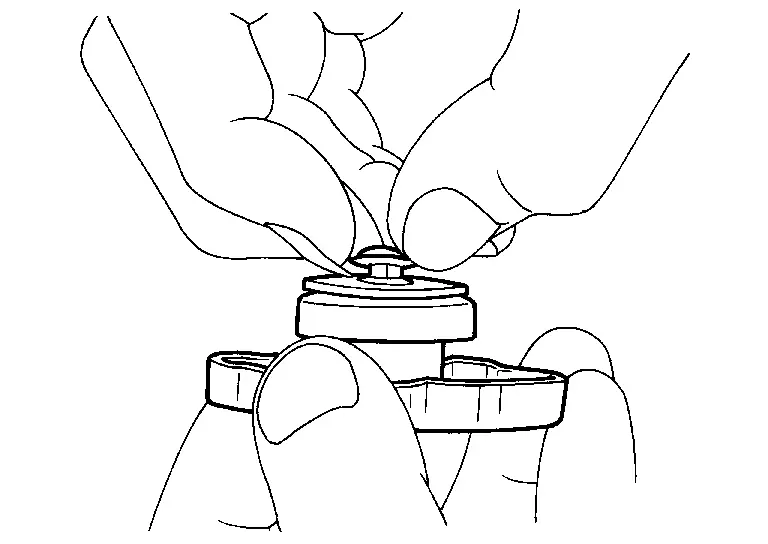
-
Replace the radiator cap if the negative-pressure valve does not close completely when pulled open and released.
-
Replace the radiator cap if there is damage or deposits of foreign material on the valve seat of the negative-pressure valve.
-
Replace the radiator cap if there is an abnormality in the operation of the negative-pressure valve.
-
-
Check radiator cap relief pressure.
-
Check the radiator cap relief pressure using Tools (A) and (B), and suitable tool (C).
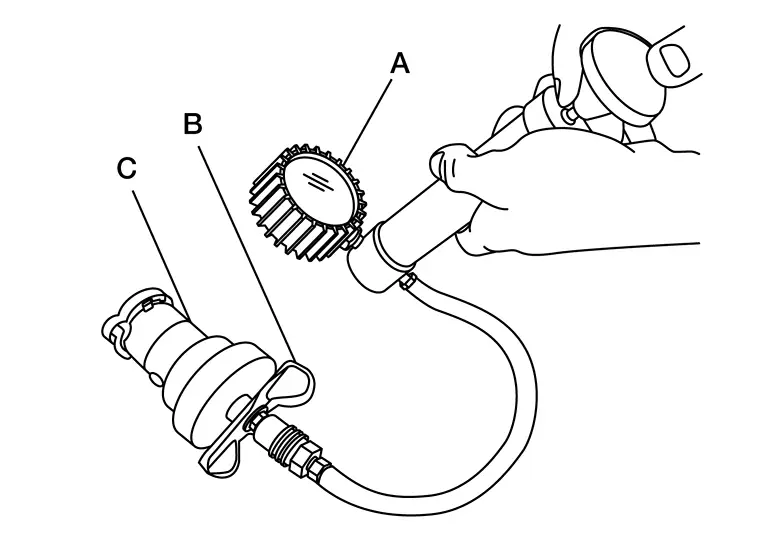
Tool number (A) : — (NI-51771-5) Tool number (B) : — (NI-51771-9) Tool number (C)
(commercially available): — (NI-33984-A or equivalent) Radiator cap relief
pressure: Refer to Radiator. -
When connecting the radiator cap to suitable tool (C), apply water or coolant to the radiator cap seal surface.
-
Replace the radiator cap if the radiator cap relief pressure is outside of specification.
-
CHECKING RADIATOR
Check radiator for mud or clogging. If necessary, clean radiator as follows.
CAUTION:
-
Be careful not to bend or damage the radiator fins.
-
When radiator is cleaned on-Nissan Pathfinder vehicle, remove surrounding parts in order to access the radiator core. Tape the harness and electrical connectors to prevent water from entering.
-
Spray water to the back side of the radiator core using a side to side motion from the top down.
-
Stop spraying when debris no longer flows from radiator core.
-
Blow air into the back side of radiator core using a side to side motion from the top down.
-
Use compressed air lower than 490 kPa (4.9 bar, 5 kg/cm2, 71 psi) and keep distance more than 30 cm (11.8 in).
-
-
Continue to blow air until no water sprays out.
-
Check for engine coolant leaks. Repair as necessary.
Draining
WARNING:
-
Do not remove the radiator cap or reservoir tank cap when the engine is hot. Serious burns could occur from high-pressure engine coolant escaping from the cooling system.
-
When removing the radiator cap or reservoir tank cap, wrap a thick cloth around the cap and slowly turn it a quarter turn to allow built-up pressure to escape. Then carefully remove the cap by turning it all the way.
Open radiator drain plug (1) at the bottom of radiator and remove the radiator filler cap.
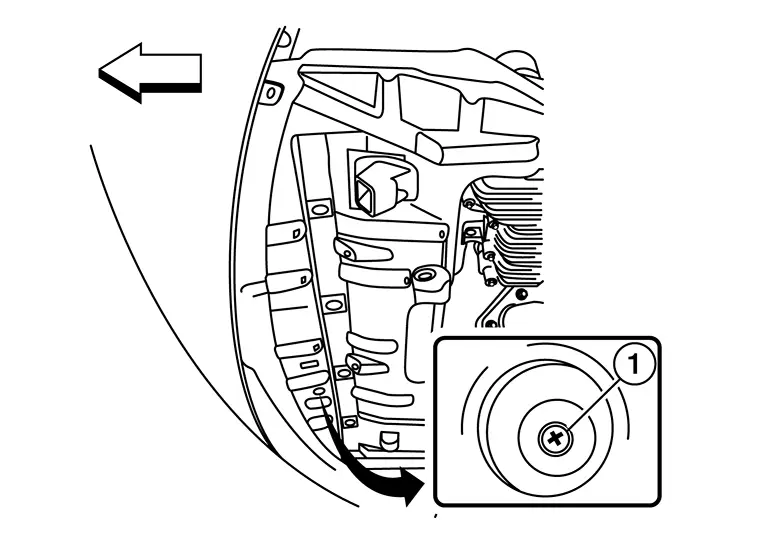
 |
: Front |
For a complete cooling system drain, remove the reservoir tank and drain the engine coolant, and then clean the reservoir tank before installation.
CAUTION:
Do not allow the engine coolant to contact the drive belt.
When performing a complete cooling system drain, remove the water drain plug (B), connector bolt (C), and copper sealing washer (A) on the cylinder block.
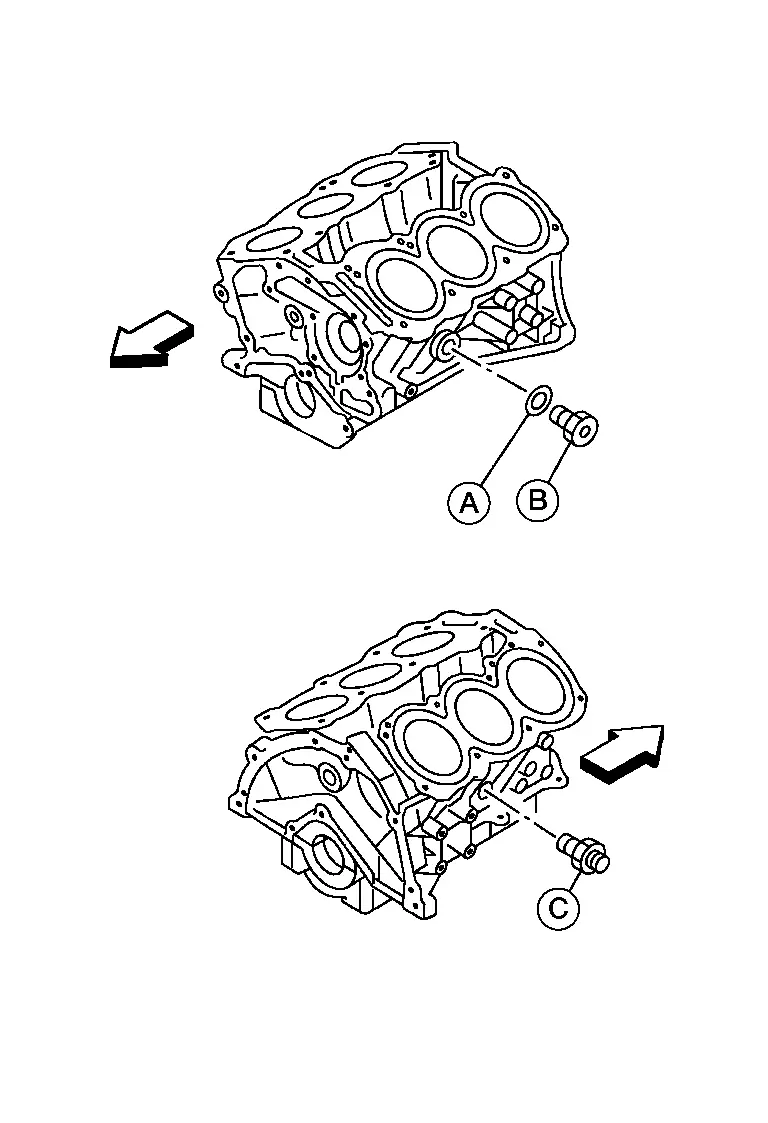
CAUTION:
Do not reuse copper sealing washers.
 |
: Engine front |
Check the drained engine coolant for contaminants such as rust, corrosion or discoloration.
-
If contaminated, flush the engine cooling system. Refer to Flushing.
Refilling
Install the following, if removed:
-
Cylinder block drain plugs, refer to Exploded View.
-
Reservoir tank, refer to Exploded View.
-
Cooling system hoses, refer to Exploded View.
-
Radiator drain plug, refer to Exploded View.
Set the Nissan Pathfinder vehicle heater controls to the full HOT and heater ON positions. Place the vehicle ignition in the "ON" position with the engine OFF as necessary to activate the heater mode.
Fill the cooling system with engine coolant using Tool (A), following the manufacturer’s instructions included with the tool.
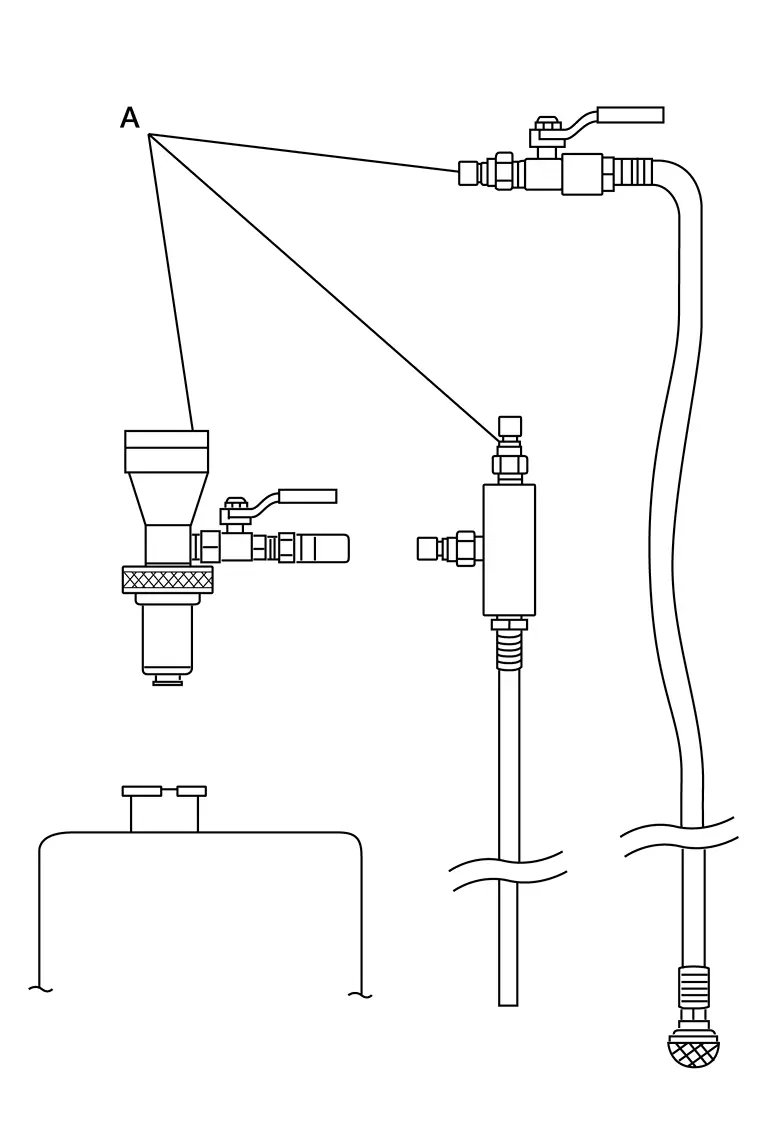
| Tool number (A) | : KV991J0070 (NI-45695-A) |
| Engine Coolant | : Refer to Fluids and Lubricants (United States and Canada) or Fluids and Lubricants (Mexico). |
CAUTION:
-
Use recommended coolant or equivalent.
-
Do not use any cooling system additives such as radiator sealer. Additives may clog the cooling system and cause damage to the engine, transmission or cooling system.
-
The compressed air supply must be equipped with an air dryer.
 NOTE:
NOTE:
When installing Tool (A) to radiator cap filler neck, make sure to select the correct size expansion plug (B).
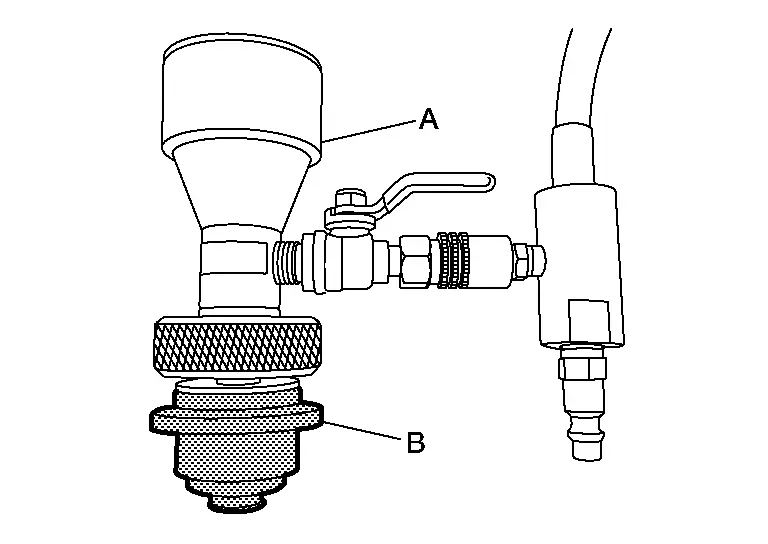
Remove the Tool (A) and top off the cooling system with engine coolant as necessary.
Install the radiator cap and reservoir tank cap.
Run the engine until it reaches normal operating temperature.
CAUTION:
Do not allow the engine to exceed normal operating temperature or engine damage may occur.
Stop the engine and allow it to cool.
Check the engine coolant level and adjust if necessary.
Flushing
Fill the radiator from the filler neck above the radiator upper hose and reservoir tank with clean water and reinstall radiator filler cap.
Run the engine until it is at normal operating temperature.
Rev the engine two or three times under no-load.
Stop the engine and wait until it cools down.
Drain the water from the system.
Repeat steps 1 through 5 until clear water begins to drain from the radiator.

Nissan Pathfinder (R53) 2022-2025 Service Manual
Contact Us
Nissan Pathfinder Info Center
Email: info@nipathfinder.com
Phone: +1 (800) 123-4567
Address: 123 Pathfinder Blvd, Nashville, TN 37214, USA
Working Hours: Mon–Fri, 9:00 AM – 5:00 PM (EST)
